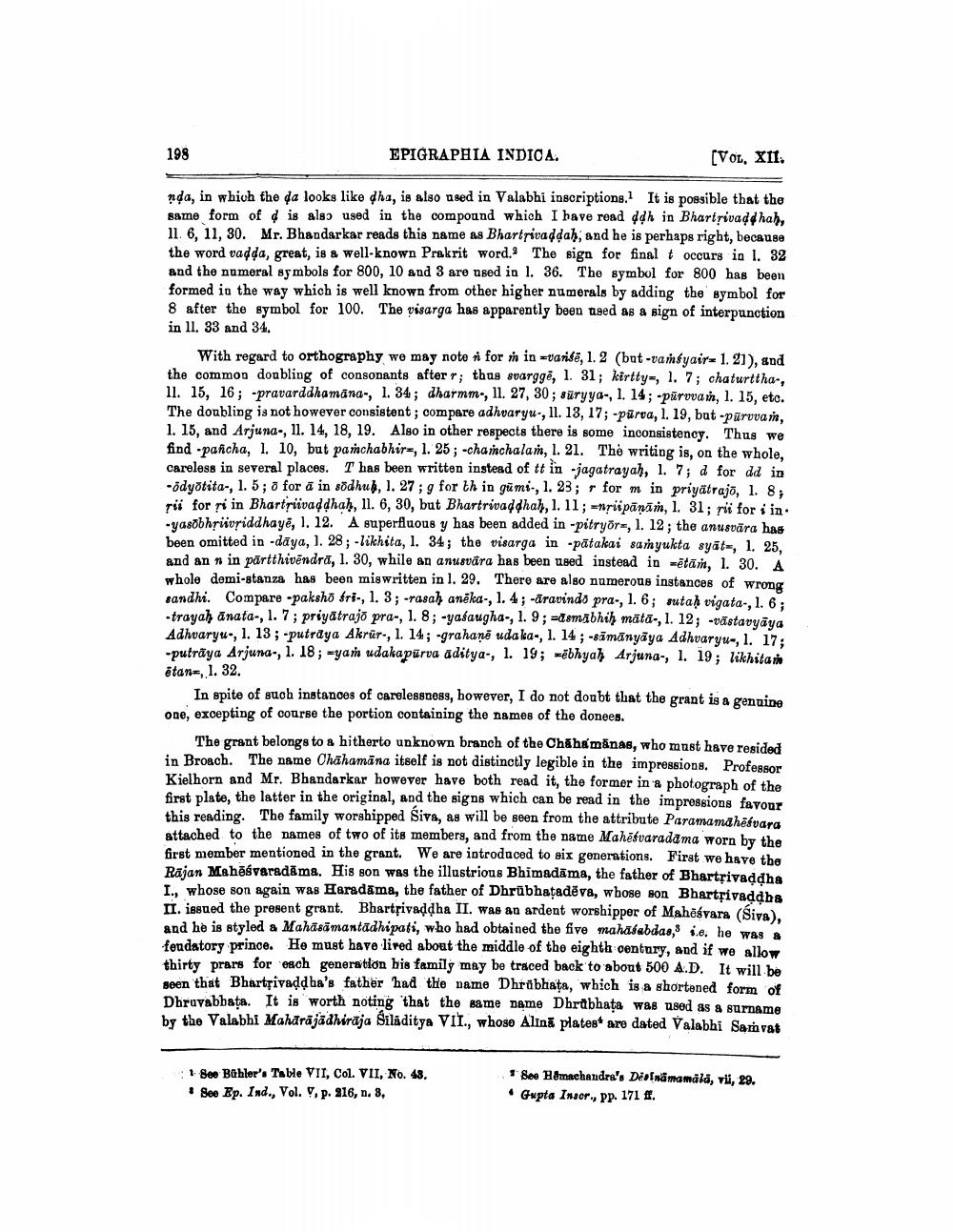________________
198
EPIGRAPHIA INDICA.
[Vol. XII.
nda, in which the da looks like dha, is also used in Valabhi inscriptions. It is possible that the same form of dis also used in the compound which I have read ddh in Bhartsivadd hah, 11. 6, 11, 30. Mr. Bhandarkar reads this name as Bhartsivaddah, and he is perhaps right, because the word vadda, great, is a well-known Prakrit word. The sign for final toccurs in I. 32 and the numeral symbols for 800, 10 and 3 are used in l. 36. The symbol for 800 has been formed in the way which is well known from other higher numerals by adding the symbol for 8 after the symbol for 100. The visarga has apparently been tused as a sign of interpunction in 11. 33 and 34.
With regard to orthography wo may note for r in varisë, 1.2 (but-vamsyair= 1.2]), and the common doubling of consonants after r; thus svarggé, 1. 31; kirttys, 1. 7; chaturttha, 11. 15, 16; pravarddhamana-, 1. 34; dharmm., 11. 27, 30; sūryya-, 1. 14; -pūrovam, l. 15, etc. The doubling is not however consistent; compare adhvaryu., 11. 13, 17; pūrva, 1. 19, but -pūruvam, 1. 15, and Arjuna., 11. 14, 18, 19. Also in other respects there is some inconsistency. Thus we find -pancha, 1. 10, but panchabhirs, 1. 25; -chanchalam, 1. 21. The writing is, on the whole, careless in several places. T has been written instead of tt in jagatrayah, 1. 7; d for dd in -odyotita-, 1.5; 0 for a in sõdhub, 1. 27; 9 for th in güms., 1. 23; r for m in priyatrajā, 1. 8, rü for ri in Bhartrüvaddhah, 11. 6, 30, but Bhartriad dhah, 1. 11; = rispānā, 1. 31; ri for i in. -yasobhriivriddhayē, 1. 12. A superfluous y has been added in -pitryors, 1. 12; the anusvāra has been omitted in -dāya, 1. 28; -likhita, 1. 34; the visarga in pātakai samyukta syāts, 1. 25, and ann in partthivēndra, l. 30, while an anusvára has been used instead in mētāri, 1. 30. A whole demi-stanza has been miswritten in l. 29. There are also numerous instances of wrong sandhi. Compare -paksho fri., 1. 3; -rasah anēka-, 1.4; -ravindo pra., 1. 6; mutah vigata-, 1. 6: trayah anata, 1.7; priyatrajo pra-, 1. 8; -yazaugha., 1. 9; =demābhih mäta., 1. 12; -västavyāva Adhvaryu-, 1. 13; -putrdya Akrür., 1. 14; -grahanë uda ka-, 1. 14 ; -sīmānyāya Adhvaryu-, l. 17; -putrāya Arjuna-, 1. 18; =ya udakapūrva aditya-, 1. 19; =ēbhyah Arjuna-, 1. 19; likhitar ētans, 1. 32.
In spite of such instances of carelessness, however, I do not doubt that the grant is a genuine one, excepting of course the portion containing the names of the donees.
The grant belongs to a hitherto unknown branch of the Chahámánas, who must have resided in Broach. The name Chāhamāna itself is not distinctly legible in the impressions. Professor Kielhorn and Mr. Bhandarkar however have both read it, the former in a photograph of the first plate, the latter in the original, and the signs which can be read in the impressions favour this reading. The family worshipped Siva, as will be seen from the attribute Paramamahēšvara attached to the names of two of its members, and from the name Mahētvaradama worn by the first member mentioned in the grant. We are introduced to six generations. First we have the Rajan Mahēsvaradama. His son was the illustrious Bhimadama, the father of Bhartrivaddha I., whose son again was Haradāma, the father of Dhrubhataděva, whose son Bhartsivaddha II. issued the present grant. Bhartsivaddha II. Was an ardent worshipper of Mahöśvara (siva). and he is styled a Mahasamantadhipati, who had obtained the five mahāšabdas, ie, he was & fendatory prince. He must have lired about the middle of the eighth oentury, and if we allow thirty prars for each generation his family may be traced back to about 500 A.D. It will be seen that Bhartsivaddha's father had the name Dhrubhata, which is a shortened form of Dhruvabhata. It is worth noting that the same name Dhrubhata was used as a surname by the Valabhi Maharājādhiraja Šiladitya VII., whose Alinā plates are dated Valabhi Samvat
1 See Bühler's Table VII, Col. VII, No. 48. . See Ep. Ind., Vol. 5, p. 216, n. 8.
* See Hamachandra's Derinamamala, vii, 29. • Gupta Insor., pp. 171 4.




